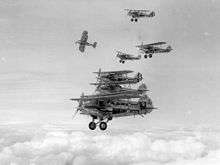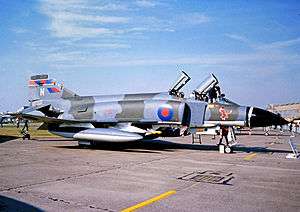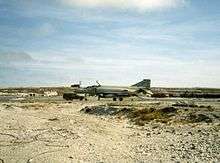No. 23 Squadron RAF
| No. 23 Squadron RAF | |
|---|---|
|
Official Squadron Badge of No. 23 Squadron RAF | |
| Active |
1 September 1915 – 31 December 1919 1 July 1925 – September 1945 1 September 1946 – 31 October 1975 1 November 1975 – 31 October 1988 1 November 1988 – 3 October 2009 |
| Country |
|
| Branch |
|
| Motto(s) |
Latin: Semper Aggressus ("Always on the attack")[1] |
| Colors |
 |
| Equipment | E-3 Sentry |
| Battle honours |
Home Defence 1916*, Western Front 1916–1918, Somme 1916, Arras, Ypres 1917*, Somme 1918*, Channel & North Sea 1939–1940*, Fortress Europe 1940–1944, North Africa 1943*, Sicily 1943, Italy 1943–1944*, Anzio & Nettuno*, France & Germany 1944–1945*, Ruhr 1944–1945, Kosovo, Iraq 2003. Honours marked with an asterisk* are emblazoned on the Squadron Standard |
| Insignia | |
| Squadron Badge heraldry | An eagle preying on a falcon |
| Squadron Codes |
MS Sep 1938 – Sep 1939 YP (Sep 1939 – May 1945 and Sep 1946 – Apr 1951) E (Carried on Tornados) |
No. 23 Squadron was a squadron of the Royal Air Force. Until October 2009, it operated the Boeing Sentry AEW1 Airborne Warning And Control System (AWACS) aircraft from RAF Waddington, Lincolnshire.
History
First World War
No. 23 Squadron of the Royal Flying Corps was formed at Fort Grange, Gosport on 1 September 1915, commanded by Louis Strange and equipped with a mixture of types. A detachment of Royal Aircraft Factory B.E.2C's were deployed to Sutton's Farm to act as night fighters to oppose raids by German Zeppelins, but no successful interceptions resulted.[2] The squadron moved to France on 16 March 1916 flying FE2b two-seat pusher fighters. The squadron used the FE2b on close-escort duties and to fly standing patrols to engage hostile aircraft wherever they could be found, helping to establish air superiority in the build-up to the Battle of the Somme.[3]
By the end of the year the "Fee" was obsolete, and the Squadron started to receive Spad S.VII single-seat fighters in February 1917, with its last F.E.2s in April 1917.[4] 23 Squadron flew its SPADs both on offensive fighter patrols over the front and low-level strafing attacks against German troops.[5] In December 1917 it replaced its SPAD S.VII with the more powerful and heavier armed Spad S.XIII.[5] The squadron converted to Sopwith Dolphins in April 1918 until it disbanded just after the war on 31 December 1919.[6] It numbered 19 aces among its ranks during the war, including: William Kennedy-Cochran-Patrick, DSO, MC; Douglas U. McGregor, MC; James Pearson, DFC; Clive W. Warman, DSO, MC; Frederick Gibbs, MC; Conn Standish O'Grady, MC; Herbert Drewitt, MC, AFC; James Fitz-Morris, MC; Harold Albert White, DFC; Alfred Edwin McKay, MC; Harry Compton, DFC; and Arthur Bradfield Fairclough, MC.[7]
Reformation



The squadron was re-formed on 1 July 1925 at RAF Henlow with the Sopwith Snipe,[8] then used other biplane fighters.
In 1938 it became a night-fighter squadron using the Bristol Blenheim. Following the outbreak of the Second World War, these were replaced by the Douglas Havoc and later the de Havilland Mosquito. Between 1942 and 1944 the squadron was based on Malta. It then returned to England and served as an intruder squadron, targeting German night fighters, over western Europe. 23 Sqn was disbanded, following the war's end, in September 1945.[8]
Postwar operations
The squadron was reformed on 1 September 1946 as a night fighter squadron operating the de Havilland Mosquito.[8] It received jet aircraft in the form of de Havilland Vampire NF.10s in 1953, replacing them with de Havilland Venom NF.2s in June 1954.[6] The squadron acquired Venom NF.3 in 1957.

In 1957 the squadron converted to the Gloster Javelin all-weather fighter, beginning a long period operating in the air defence role. The squadron has a strong heritage in the air defence role, operating Gloster Javelins, Lightnings, Phantoms and Tornado F3s. The squadron first acquired Phantoms on 1 November 1975 at RAF Coningsby before moving to RAF Wattisham for just under 10 years. Then in October 1983[9] the squadron deployed to Stanley airfield, Falkland Islands after their recapture from Argentina, arriving there on 1 November. They remained here until 31 October 1988 when its duty was assumed by 1435 Flight. The squadron then reformed on 1 November 1988 at RAF Leeming with the Panavia Tornado which it operated until 26 February 1994, when the unit was disbanded.[8][10]
The squadron assumed the Airborne Early Warning role upon reformation in April 1996, sharing the RAF's Sentry AEW1 fleet with No. 8 Squadron. The squadron disbanded on 2 October 2009, when it amalgamated with No 8 Squadron.[8]
Notable squadron members
Among the 19 aces that served within its ranks in World War I were William Kennedy-Cochran-Patrick, Douglas U. McGregor, James William Pearson, Clive W. Warman, Frederick J. Gibbs, Conn Standish O'Grady, Herbert Drewitt, James Fitz-Morris, Harold Albert White, Alfred Edwin McKay, Harry Compton, and Arthur Bradfield Fairclough.[11]
Douglas Bader was a member of 23 Squadron when he crashed carrying out low level aerobatics, losing his legs in the process. He went on to become one of the highest scoring aces of the RAF in World War II. Air Officer Commanding Sir Peter Wykeham was credited with shooting down at least 15 hostile aircraft at various theatres of World War II.[12] He was later promoted to Air Marshal. He served as Officer Commanding No. 38 Group from 1960, the Director of the Joint Warfare Staff from 1962, the Commander of the Far East Air Force from 1964 and the Deputy Chief of the Air Staff from 1967 before retiring in 1969. Andrew George Walton flew with the squadron in Tornados and Phantoms, and rose to the rank of Air Vice Marshal, receiving a CBE (Commander of the Order of the British Empire) in the process, before retiring in 2010.[13]
Wing Commander A J 'Red' Owen DFC and Bar, AFC, DFM, was 23 Squadron's commanding officer between May 1962 and October 1964. He was one of the RAFs most successful night fighter pilots during World War II, credited with destroying at least 15 enemy aircraft.
Aircraft operated
- Bleriot XI
- Caudron G.III
- Farman Shorthorn
- Avro 504
- Martinsyde S1
- BE2c
- FE2b
- Martinsyde G.100
- SPAD S.VII
- SPAD S.XIII
- Sopwith Dolphin
- Sopwith Snipe
- Gloster Gamecock
- Bristol Bulldog
- Hawker Hart
- Hawker Demon
- Bristol Blenheim
- Douglas Havoc I
- Douglas Boston III
- De Havilland Mosquito
- De Havilland Vampire
- De Havilland Venom
- Gloster Javelin
- English Electric Lightning
- McDonnell-Douglas Phantom FGR2
- Panavia Tornado F3
- Boeing Sentry AEW1
See also
Notes
- ↑ Rawlings 1978, p. 58.
- ↑ Halley 1971, pp. 29–30.
- ↑ Halley 1971, pp. 30–31.
- ↑ Halley 1971, pp. 31–32.
- 1 2 Halley 1971, p. 32.
- 1 2 Lewis 1959, p.22.
- ↑ http://www.theaerodrome.com/services/gbritain/rfc/23.php Retrieved 27 January 2010.
- 1 2 3 4 5 "RAF – 23 Squadron" Organisation. Royal Air Force. Retrieved 15 November 2008.
- ↑ http://www.subbrit.org.uk/rsg/sites/w/wattisham/index4.html
- ↑ Jefford 2001, p. 35.
- ↑ "23 Squadron". The Aerodrome. Retrieved 12 February 2013.
- ↑ "Royal Air Force: 2nd Tactical Air Force, 1943–1945". Imperial War Museum. Retrieved 12 February 2013.
- ↑ "Air Marshal Sir Peter Wykeham (33211)". Air of Authority – A History of RAF Organisation. Retrieved 12 February 2013.
Bibliography
- Halley, James J. Famous Fighter Squadrons of the RAF: Volume 1. Windsor, Berkshire, UK: Hylton Lacey Publishers Ltd., 1971. ISBN 0-85064- 100-4.
- Halley, James J. The Squadrons of the Royal Air Force & Commonwealth 1918–1988. Tonbridge, Kent, UK: Air Britain (Historians) Ltd., 1988. ISBN 0-85130-164-9.
- Jefford, C.G. RAF Squadrons, a Comprehensive record of the Movement and Equipment of all RAF Squadrons and their Antecedents since 1912. Shropshire, UK: Airlife Publishing, 1988 (second edition 2001). ISBN 1-85310-053-6.
- Lewis, Peter. Squadron Histories: R.F.C, R.N.A.S and R.A.F., 1912–59. London: Putnam, 1959.
- Rawlings, John. Fighter Squadrons of the RAF and their Aircraft. London: Macdonald and Jane's Publishers Ltd., 1969 (second edition 1976). ISBN 0-354-01028-X.
External links
![]() Media related to No. 23 Squadron RAF at Wikimedia Commons
Media related to No. 23 Squadron RAF at Wikimedia Commons

